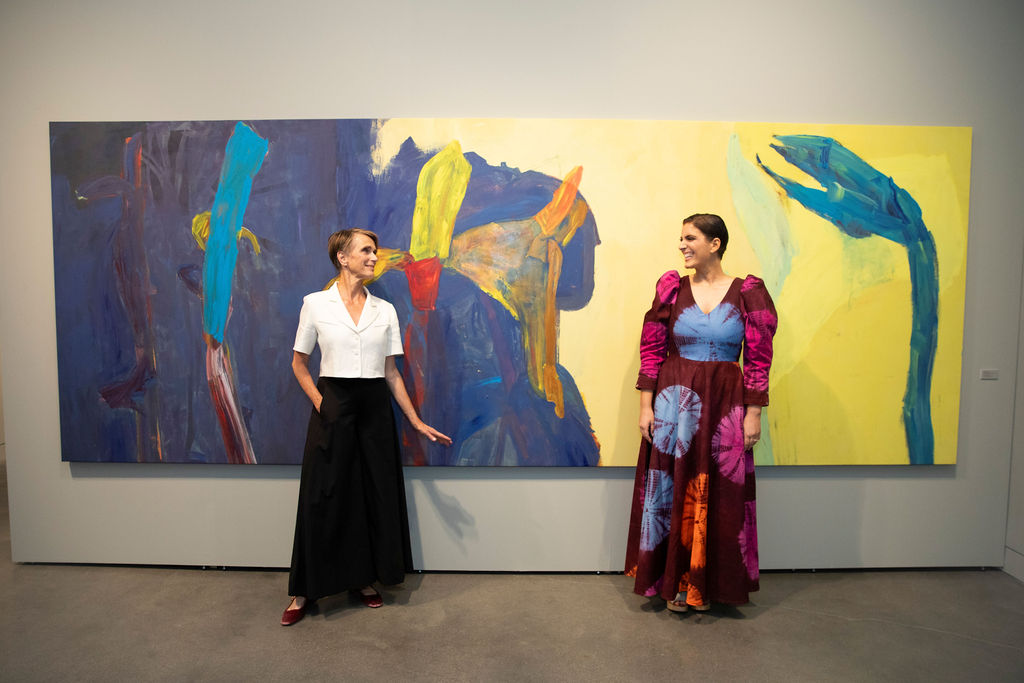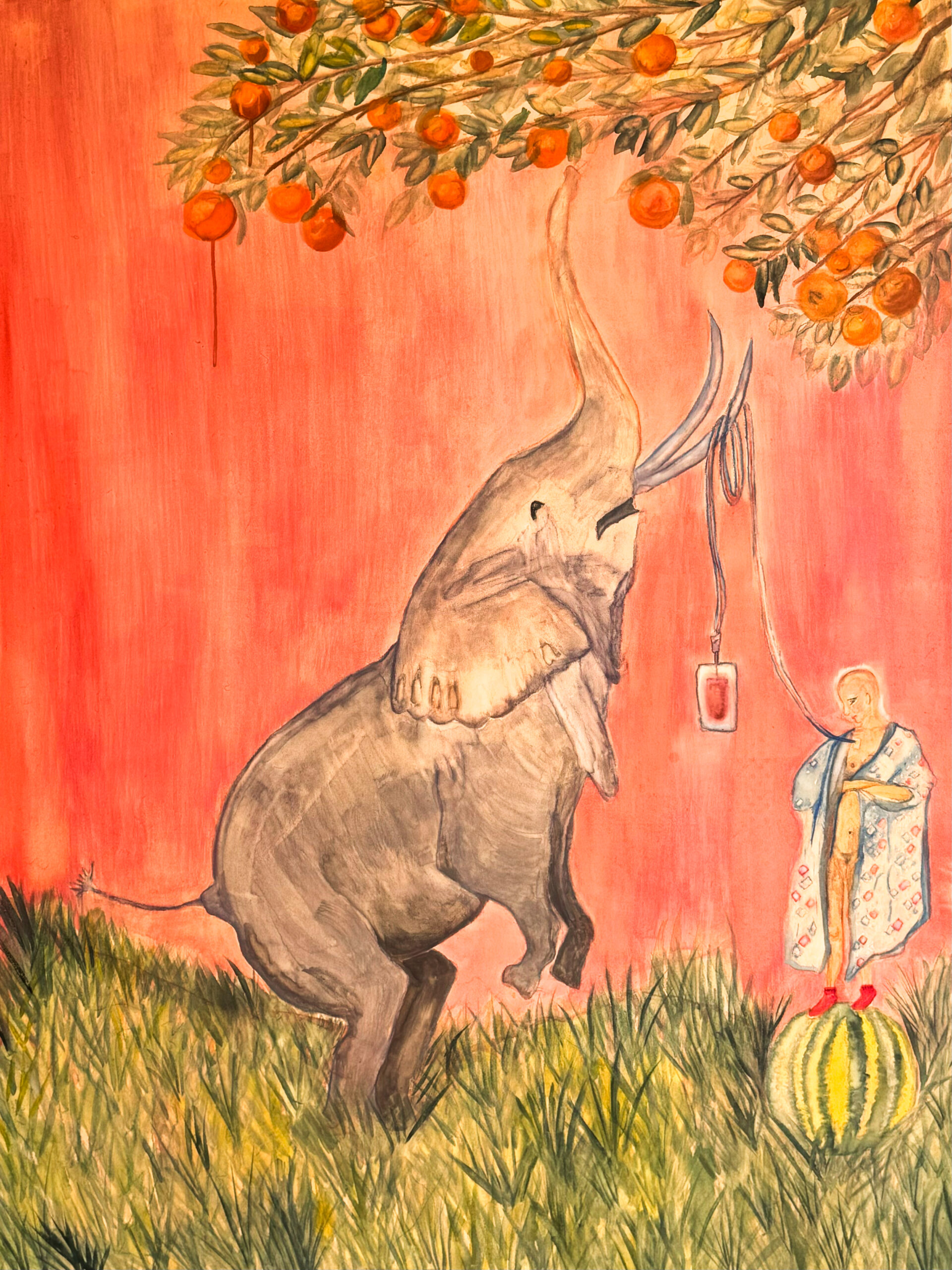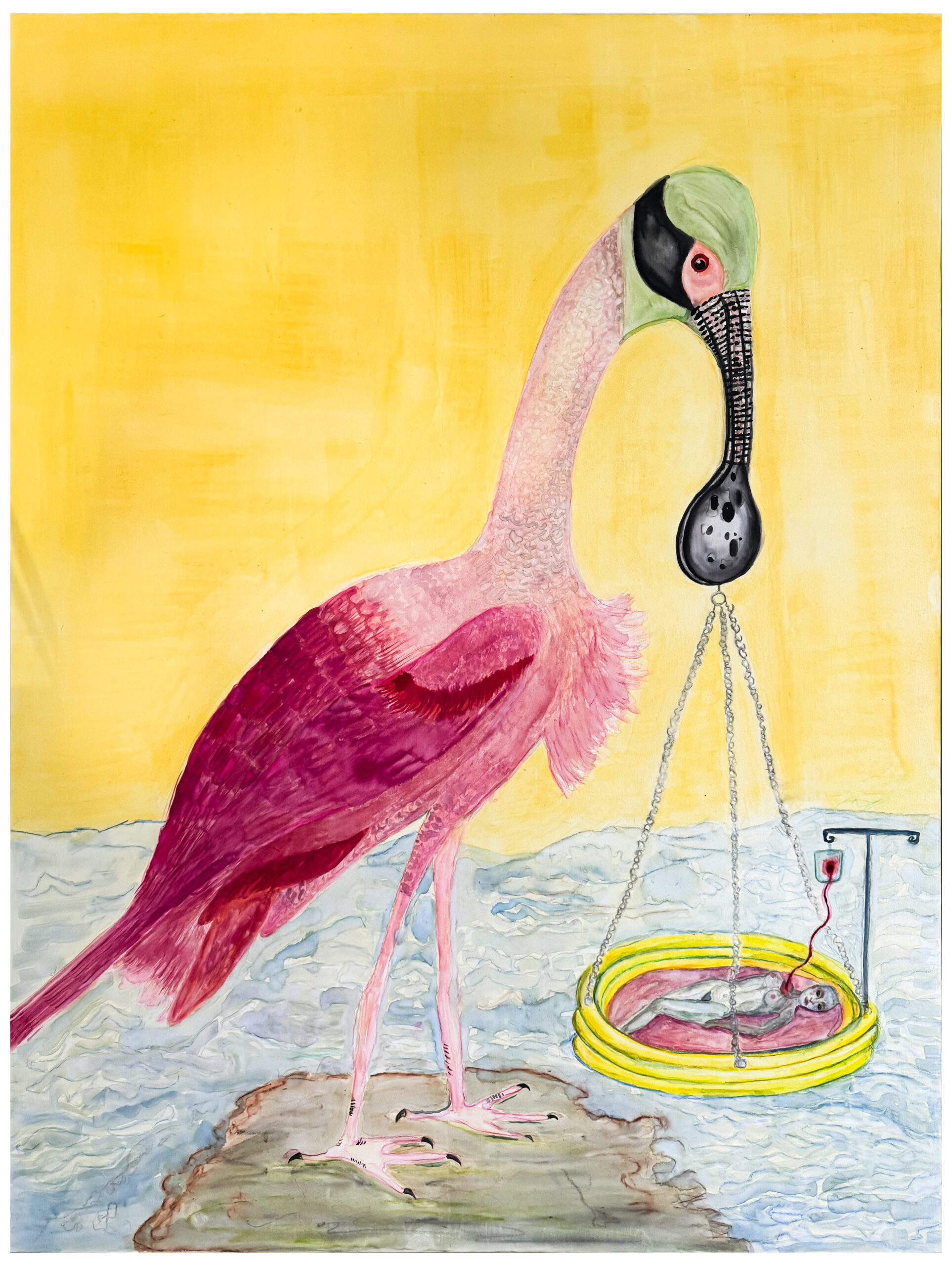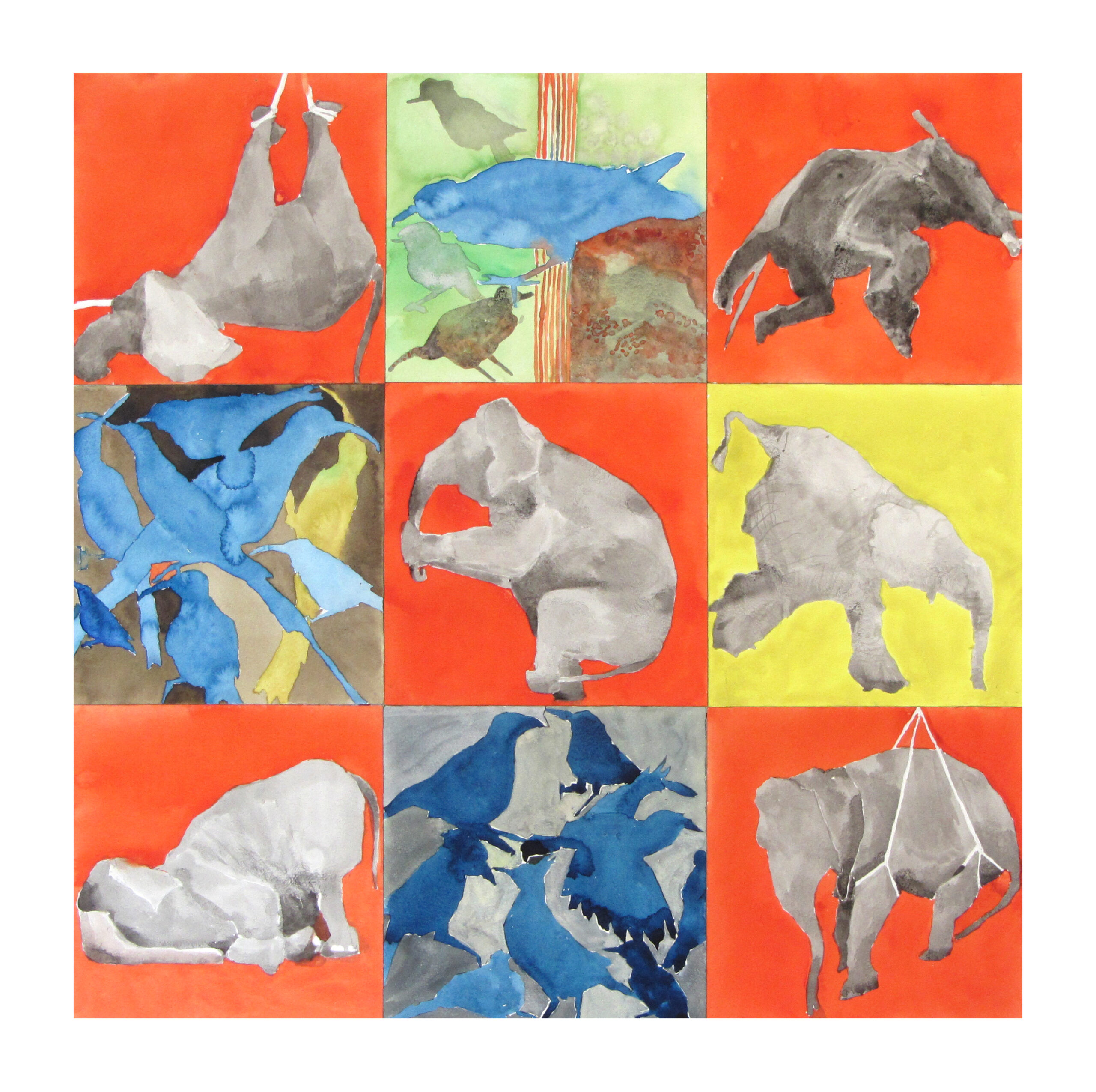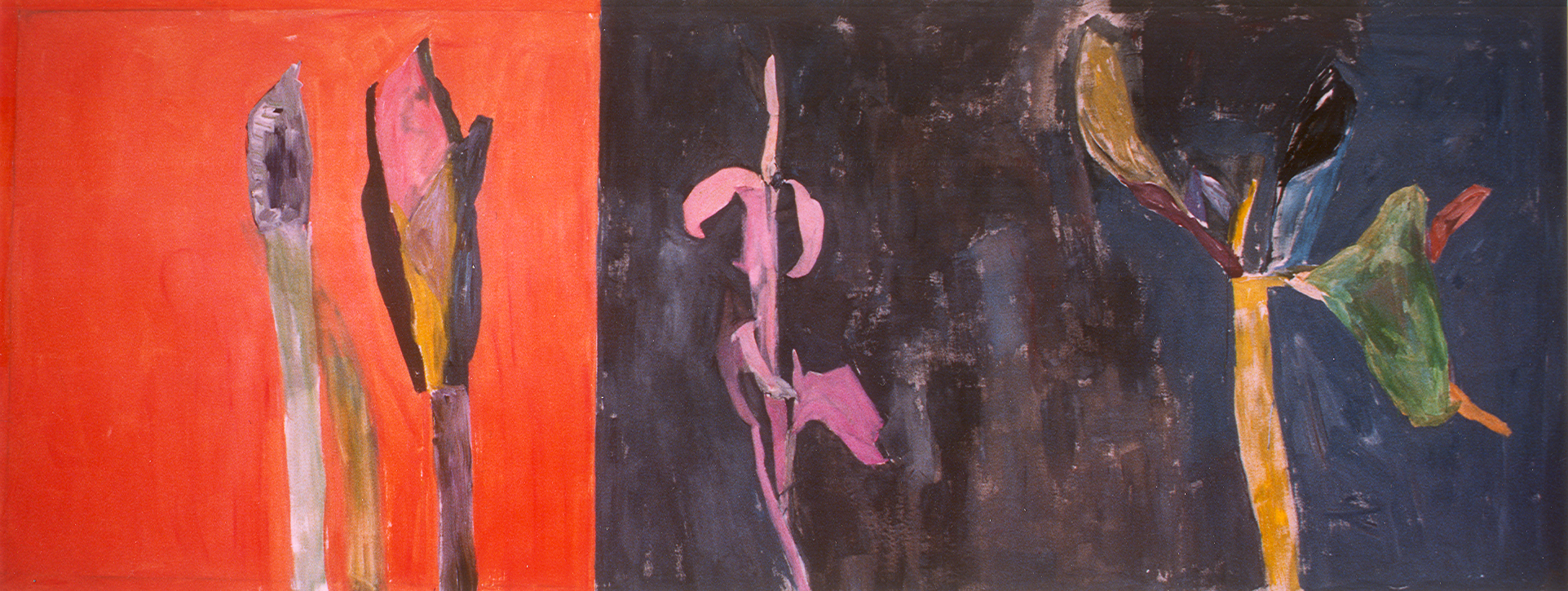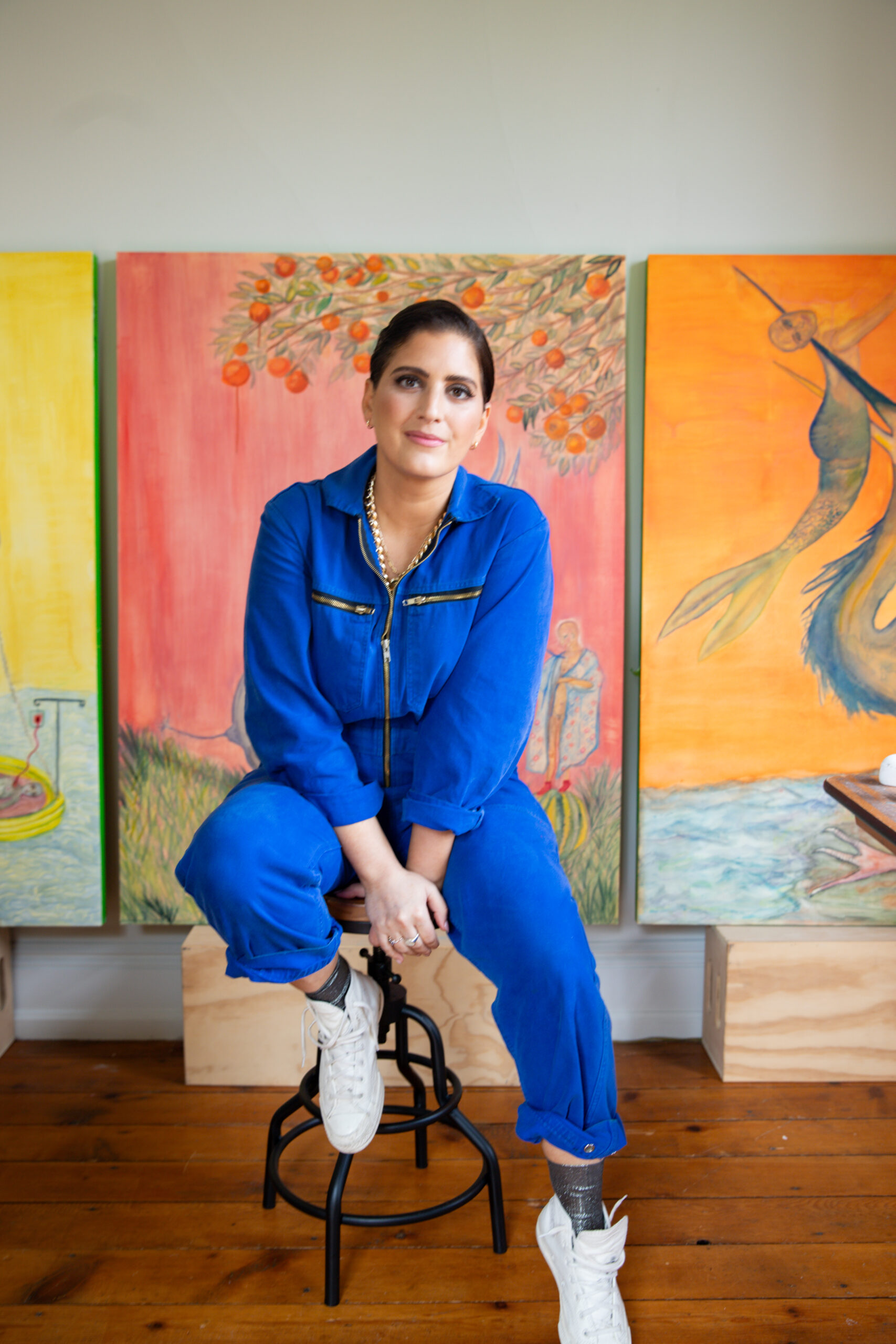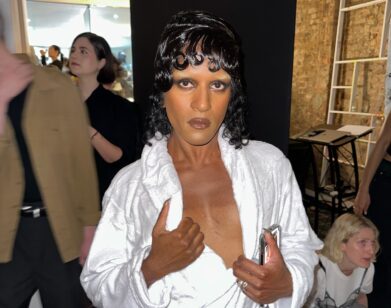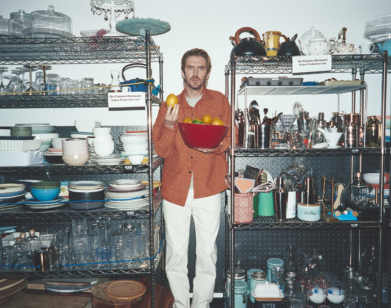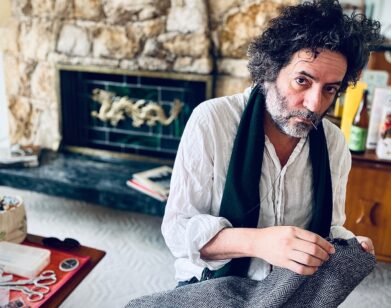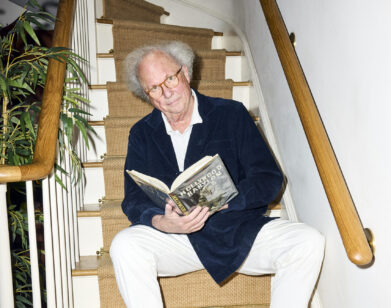IN THE FAMILY
How Mother-Daughter Duo Suleika Jaouad and Anne Francey Turned Adversity Into Art
Writer Suleika Jaouad was 22 when she was diagnosed with leukemia and began documenting her experience, becoming the author of the Emmy award-winning column “Life, Interrupted” and later The New York Times bestselling memoir, Between Two Kingdoms: A Memoir of a Life Interrupted. During the pandemic, she launched a global creative writing project called The Isolation Journals that would go on to gain nearly 200,000 participants. Then, after nearly a decade of remission, Jaouad learned in 2022 that her cancer had returned.
Back in the hospital, Jaouad found that her treatment not only temporarily impacted her vision and made it difficult to write, but also caused her to experience wild, medication-induced hallucinations. Looking for a new mode of expression, she turned to painting—the primary creative domain of her mother, the Swiss artist Anne Francey.
The paintings made from her hospital bed would go on to become the foundation for her first art exhibition, a joint venture with Francey that also features three decades of her mother’s work, including pieces from when she was pregnant with Jaouad. The exhibition, aptly titled The Alchemy of Blood, opened last month at ArtYard and runs through September 22nd. Over Zoom, just before the opening, Francey and Jaouad talked to me about approaching life with a spirit of curiosity and experimentation, weaving protective talismans out of hospital bracelets, and turning confinement into meaning.
———
GABRIELLA LACOMBE: So Suleika, I know from reading The Isolation Journals that when you started this painting project, you had no specific expectations, and now we are here with your exhibition about to open in a matter of days, and it’s public debut of not just your painting work, but also three decades of your work, Anne. So tell me about how this exhibition came together.
SULEIKA JAOUAD: So I’m not a trained painter, but I had the great privilege of living in a home where creativity in all of its various expressions was something that was encouraged and considered sacred. And so first and foremost, I’m a writer as my primary mode of creative expression, but when my leukemia returned in 2010, I knew from having been sick before that to have plans and expectations was going to be a recipe for frustration and disappointment. And so when I was admitted to the hospital for my second bone marrow transplant, I had some sense of what to expect, which was going to be many unpredictable weeks in the hospital in medical isolation. So I packed a diaper caddy and threw in everything that I could think of that might feel creatively nourishing and inspiring. And pretty quickly upon being admitted, I experienced these side effects unlike anything I’d experienced the first time around. I was having medication-induced hallucinations and night terrors, and my vision was blurry and temporarily altered, which made it really challenging to write. So rather than trying to ignore the symptoms, I decided instead to transcribe them in the form of these little paintings that I began doing. And they were purely for myself with no expectation of being a good artist or a bad artist, and there was something really liberating about that. And the more I began to paint this sort of surreal dreamscape that I found myself in, the more it suddenly felt like this space of confinement was becoming this space incandescent with meaning and symbolism and imagery. And when I was first invited to do a show of my work at ArtYard, I felt really resistant to the idea because it was something I was really just doing for myself. I did not consider myself a painter, but when the curator and I started talking and she came up with the idea of doing a joint exhibit with my mom and me, something about that felt really special because everything I know about visual art, and creativity as a whole, comes from my mom. She’s been my greatest teacher, not just on the canvas, but also in terms of adaptability and spontaneity and harnessing that sense of curiosity and play that we have so naturally as children that we often lose as we get older. And so it’s my first time showing these brand-new paintings, which are inspired by the hospital studies I did from my bed, and I made 10 of them.
LACOMBE: That’s really stunning. And so this exhibition combines your watercolors and then both paintings and physical items made from both the shields and items made from hospital ephemera from you, Anne. I’m wondering if you could talk about how you chose the mediums that you did?
ANN FRANCEY: It’s interesting because Suleika started to write about her illness very publicly. And I was unable to even write in my own daily journal. I was scared of words, I didn’t want to say things. So the art was my only way to express myself, and that’s how I started with these daily ceramic pieces that I started to assemble little by little into these magical shields that were supposed to protect Suleika, which I believe they did. So that’s how it started in a way, keeping a distance from saying things out loud, but at the same time, the very deep need to do something and be active creatively. And then the second body of work that is being shown in this exhibition is mostly made of ceramic pieces that were inspired by a burial suit that was made in the Han Dynasty that was supposed to be accompanying the noble deceased into the afterworld and guarantee them immortality. It was very beautiful and peaceful. And that’s what inspired me to come up with this technique of tying very small, rectangular pieces that are pierced on each corner and then are tied together and are tied into the form of almost a kimono-like shape. And the older work that I did when I was pregnant with Suleika, which is also in the exhibition, are two very large paintings that are 14-feet long that I did at an artist residency. I was inspired by plants and flowers that I surrounded myself with in the studio and which were presenting a life force that was burgeoning inside of me, and representing my desire to stay alive as an artist. There’s also one last piece, going back to the shields, that was made two years ago when she relapsed. And this time was a much lighter type of shield that I constructed from what I could find in New York because we were not at home, but also I think I was able to be more literal about what was happening. So I took diary excerpts—because then I could write again—and hospital bracelets that I wove together into this paper shield.
JAOUAD: And I’ll just add that she gathered hundreds of hospital bracelets. And in my first couple of months in the hospital, there were the typical white hospital bracelets that I would get, but visitors would get these multicolored bands. And at some point, they switched to ugly plastic ones and she was like, “No, I need the colorful, beautiful paper bands!”
FRANCEY: Yeah, I almost bribed the people who gave them out. I would go and beg them and say, “Can you please give me the leftovers if you’re not going to use them?” But the new ugly ones are incorporated into this shield and they turn very plastic-y, but in an interesting manner.
LACOMBE: That’s really interesting. So both of your works are telling a story about humans, whether it was Anne, your pregnancy, or Suleika, your time in a hospital, but both of you leaned on themes of flora and fauna. So I’m curious, when telling a story about a human experience, what directed your interest to the animal and plant kingdom?
FRANCEY: Well, when I started with the flower and plant shapes, it was very unconscious in the sense that my choice of subject matters is always from observation. And before that, I had lived in Switzerland where I was born, and I drew very abstract landscapes for a long time. Then I came to the city and I was doing more organic shapes, versus the straight lines of the human habitations. And then I went to this artist’s residency, and it was the first time that I started from flowers and plants. I was very unaware of what it meant. And now looking back, it was very clearly inspired by what was happening to my body. I also think the idea of something alive and that changes all the time is something that is always my main subject, the shields as well are not necessarily inspired by biological forms, but they do express the idea of time changing, of things taking shape and being assembled into a whole narrative. As for Suleika, I have to say that I was going through family albums because we were looking for pictures and I discovered unbelievable drawings from you, Suleika, of horses and animals and dogs, because it was a great love of your life. Since you were five years old, you were already drawing animals.
JAOUAD: Yes, I love animals. I have a little growing menagerie of rescue dogs. I would adopt every animal I could and live on a farm if it were possible. But I was very much a city girl before I got sick. And I’ll never forget, when I was 22 and was first admitted to the hospital for what I knew would be a very long stay, that walk up Fifth Avenue with my parents to the hospital. I think when you’re facing death, there’s a way in which the world feels elemental and you really hone in on the tiny, simple things that would otherwise go unnoticed. I just remember wanting to record the blue of the sky and taking note of each tree we were passing and the feeling of the sun on my hair and the breeze against my skin. And I ended up spending those next six weeks in a hospital where I couldn’t leave the room, I couldn’t even open the window. And when you exist in that kind of confinement under fluorescent lights, there’s nothing that feels more miraculous than the possibility of being in nature. As for the animals in my paintings, I relate to my mom. The way I go into making these paintings is that I have some kind of a vision, whether it’s in a dream or a figment of one of the hallucinations I had while in the hospital, and that vision keeps persisting until I start to paint it. And I made this series where, in almost every painting, there’s a central animal character that’s present, without really wanting to decode the why of it until after I was done. And earlier this week, I went to the gallery once the work was being hung and I was sitting on the floor and looking at one of the very first paintings I made, which is this vibrant, pink, Roseate Spoonbill that’s so large, it doesn’t even fit within the confines of the canvas. And from its beak is a chain connected to a neon yellow kiddie pool and a seasick-green, naked, young woman who’s laying in it. And then I started thinking, “Oh, the Roseate Spoonbillis a bird that lives in the swamps of the Gulf, where my husband is from.” And that bright, vibrant pink is his signature color. It’s the suit he wore in his music video, “Freedom,” it’s the pink suit he wore at our wedding the eve that I was admitted to the hospital. And at the time of my illness, that’s what the world was seeing was the kind of dazzling, vibrant, bright colors and not what was happening underneath the surface. And so the title I came up with for the painting was Just Married. And not all of the paintings have that literal of an application to real-world events, but I think the animals for me feel like almost Book of Revelation-esque symbols and this kind of nightmarish, biblical journey that has been the last few years.
LACOMBE: I find it interesting that in response to these immense times of uncertainty, both of you turned to creating. And I wonder if you can tell me about where that reaction came from.
JAOUAD: So, I did not feel creative whatsoever when I first got sick at 22. I felt angry. I felt scared. I felt sad. I felt envious of my peers who were traveling and starting their careers and going to parties and all the other big and small milestones of young adulthood. I really felt like my life was over before it had really begun, and things were not going well for me in that first year of treatment. The standard chemotherapy did not work. I enrolled in a phase II experimental clinical trial that had life-threatening complications and meant I was constantly being hospitalized. I think I spent something like four or five of those first eight months in the hospital deeply isolated, and I didn’t know what to do with myself. And we live in a culture that is obsessed with productivity and hustle and our resumes, and I didn’t have any of that. I didn’t have anything that I was focused on other than simply surviving and trying to get through every day. It was around that time that my mom gifted me a copy of Frida Kahlo’s diary, and I kept it in a stack of books on my bedside. And I had always loved Frida Kahlo from the time I was a teenager with a unibrow. But of course, in the circumstances in which I found myself, her story held a deeper sense of resonance. She had famously been injured and left bedridden at around the same age that I was, and her mother had gifted her a lap easel and that’s when she really began to paint. So in reflecting on her and this long lineage of artists and writers who, for various reasons, found themselves bedridden and managed to creatively engage with their circumstances, I started to think about what I could do. And that started with writing in the privacy of a journal and it turned into, much later, writing the “Life, Interrupted” New York Times column and then painting. And the really humbling lesson for me, was that the mere act of surviving really is its own kind of creative act. I would get these horrific mouth sores from the chemo that made it impossible and extremely painful for me to talk. So I had to find new ways of being in communion and conversation with my loved ones. When I was too weak or sick to get out of bed, I had to use my imagination to travel beyond it.
LACOMBE: And can you talk about what that experience was like of coming together as creative collaborators, and if you felt like you related to each other in a different way as creative collaborators versus as mother and daughter?
FRANCEY: To me, it’s almost like an ongoing conversation that started with my little one when she first came to my art classes that I was teaching in my studio when my kids were a little, or even before when you were making watercolors actually. And now, it’s so interesting because it puts us back into talking about all these difficult times that have happened, but in a very different and beautiful way. And it’s only starting, in a way, because we are just putting the show together. And I’m just looking forward to what is going to happen from that point of view when we see our work together. It’s incredibly moving and almost like the feeling of things going, not in a cycle, but as a circle. I remember when Suleika was born, I had this imagery in my head of, “Oh, this is a little planet that goes up,” and the fear that mine would be going down as it should. And it’s not like that. We are part of this whole constellation cycle that we are now looking at a little closer as mother and daughter, around this incredibly beautiful thing of having a child being born, and the difficult thing of having my child’s life being threatened in this fashion. And also, what is very beautiful for me is to see the depth of Suleika’s creativity and understanding of elements of expression in art, through painting, that she has never formally studied. And when we talk about it, she gets it. Maybe it’s the same as when we talk about writing, and that’s not my craft, but we can have an amazing conversation. It’s way beyond the idea of mother and child, it’s really communication on a deep level.
JAOUAD: And I’ll just add to that, that one of the great joys for me during this month I spent in the hospital for the second transplant is that every day when my mom would come to the hospital, rather than focusing on whatever scary test result had come back, what unexpected complication had arisen in the night, I was so excited to show her whatever I’d painted, and then for my painting lesson, which is what we did. And it was so wonderful to have this creative work to focus on that, of course, was born out of the circumstances we found ourselves in. And even as I got better and my mom and dad returned to Tunisia, I would FaceTime my mom to show her whatever I was working on and to say, “what do you think?” And to get to have these new, wide-ranging conversations feels like such a gift, especially during a time where it would be so easy to just be mired in fear and panic.

